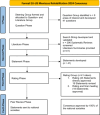The formal EU-US Meniscus Rehabilitation 2024 Consensus: An ESSKA-AOSSM-AASPT initiative. Part II-Prevention, non-operative treatment and return to sport
- PMID: 40501314
- PMCID: PMC12310080
- DOI: 10.1002/ksa.12689
The formal EU-US Meniscus Rehabilitation 2024 Consensus: An ESSKA-AOSSM-AASPT initiative. Part II-Prevention, non-operative treatment and return to sport
Abstract
Purpose: Part two of this consensus aimed to provide recommendations for the prevention of meniscus injuries, non-operative treatment of acute tears and degenerative lesions, return to sports and patient-reported outcome measures.
Methods: This consensus followed the European Society of Knee Surgery, Sports Traumatology and Arthroscopy (ESSKA) formal consensus methodology. For this combined ESSKA-American Orthopedic Society for Sports Medicine (AOSSM)-American Academy of Sports Physical Therapy (AASPT) initiative, 67 experts from 14 countries, including orthopedic surgeons and physiotherapists, were involved. The 26 Steering Group members established guiding questions, screened the existing evidence, and proposed statements, and provided Grades of recommendations. The 41 Rating Group members assessed the statements according to a Likert scale (1-9). Final documents were assessed by an international peer review group for geographical adaptability.
Results: Low to moderate scientific level of evidence was available, so that grades of recommendations were low (three Grade A ratings, four Grade B, three Grade C and 13 Grade D), underlining the relevance of this consensus. One strong and 17 relative agreements with overall median of 8 (8-9) and a mean of 7.92 ± 0.37 were achieved for 23 statements on 18 questions. Prevention of meniscus injuries is possible with general knee injury reduction programmes and through avoidance of certain activities. Non-operative treatment including physical therapy is the first line approach for degenerative meniscus lesions and may be an option for some acute tears. Return to sports after meniscus tear surgery should be both criterion-based and time-based. Patient reported outcomes in combination with performance-based measures are recommended to evaluate the rehabilitation process.
Conclusion: This international EU-US consensus established recommendations for prevention strategies, describes rehabilitation of non-operated patients and of patients after partial meniscectomy, meniscus repair and meniscus reconstruction, and establishes return to sport criteria. These updated and structured recommendations may be applied by surgeons and physiotherapists.
Level of evidence: Level I, consensus.
Keywords: knee; meniscectomy; non‐operative treatment; physical therapy; physiotherapy; repair.
© 2025 The Author(s). Co‐published by European Society of Sports Traumatology, Knee Surgery and Arthroscopy, American Orthopaedic Society for Sports Medicine, North American Sports Medicine Institute and Movement Science Media.
Conflict of interest statement
Nicolas Pujol: occasional consultant for education for Smith & Nephew, Stryker, ZimmerBiomet. Philippe Beaufils: ESSKA Consensus Projects advisor. Stephanie Wong: Editor‐in‐Chief of Current Reviews in Musculoskeletal Medicine. Robert Prill: Chair of the ESSKA Rehabilitation Committee, Associate Editor KSSTA, occasional Consultant OPED GmbH. Airelle O. Giordano: Education Chair, AASPT. Robert F. LaPrade: Consultant: Smith and Nephew, Ossur; Royalties; Smith and Nephew, Ossur, Elsevier; Research support: AOSSM, AANA, Ossur, Smith and Nephew, Arthrex; Editorial Boards: AJSM, KSSTA, JEO, Journal of Knee Surgery; JISPT, OTSM; AOSSM: Nominating Committee; ISAKOS: Travelling Fellowship Committee, Programme Committee. Aaron J. Krych: Consulting and Royalties Arthrex, Inc. Editorial Boards: AJSM, KSSTA. AANA Board. James J. Irrgang: Currently serve as President of the Board of Directors of Movement Media Sciences/Journal of Orthopaedic & Sports Physical Therapy. Alexandre Rambaud: Member of ESSKA Rehabilitation Committee; Deputy Editor: European Rehabilitation Journal, Journal de Traumatologie du Sport, Editor‐in‐Chief of Kinésithérapie, la Revue. Laura C. Schmitt: Editorial Board: MSSE; Research Support from Arthritis Foundation and NFL Players Association. Jill K. Monson: Member AASPT Research Committee, Consultant Smith & Nephew. Mark V. Paterno: Co‐Chair AASPT Research Committee, Research Support from AOSSM/AIrCast Research Foundation. Simone Perelli: Paid consultancy for Smith & Nephew. Aleksandra Królikowska: Member of ESSKA Rehabilitation Committee. Nicky van Melick: Member of ESSKA Rehabilitation Committee. Jitka Klugarová: Deputy director of the Czech CEBHC: JBI Centre of Excellence, Czech GRADE Network, member of methodological group withing JBI and GRADE working group. The other authors did not declare any conflict of interest.
References
-
- Arundale AJH, Bizzini M, Dix C, Giordano A, Kelly R, Logerstedt DS, et al. Exercise‐based knee and anterior cruciate ligament injury prevention. J Orthop Sports Phys Ther. 2023;53:CPG1–CPG34. - PubMed
-
- Beaufils P, Saffarini M, Karlsson J, Hirschmann MT, Prill R, Becker R, et al. High scientific value of consensus is based on appropriate and rigorous methodology: the ESSKA formal consensus methodology. Knee Surg Sports Traumatol Arthrosc. 2024;33:16–20. - PubMed
Publication types
MeSH terms
LinkOut - more resources
Full Text Sources
Medical
Research Materials


